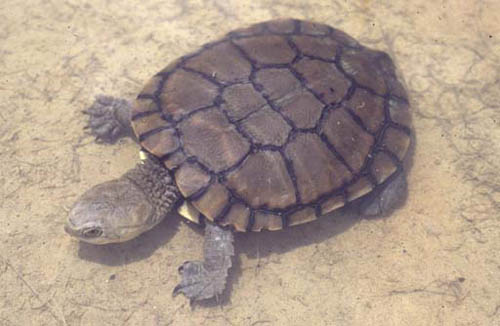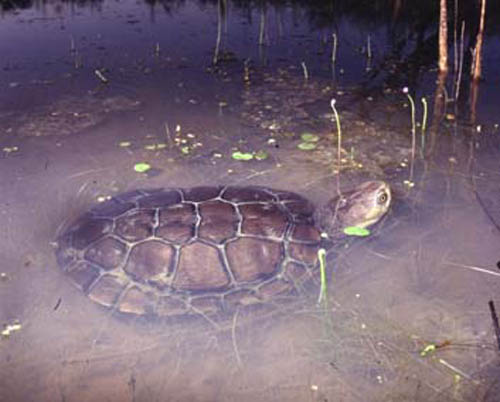Western Swamp Tortoise -- Pseudemydura umbrina
by Jan Matiaska.
 Pseudemydura
umbrina, the Western Swamp Tortoise, is a short necked turtle, which
is a single living member of the monotypic genusPseudemydura.
Pseudemydura
umbrina, the Western Swamp Tortoise, is a short necked turtle, which
is a single living member of the monotypic genusPseudemydura.
The holotype [NMW89 (8450) = 1296] was collected and sent to the Vienna
museum in 1839 by the Austrian J.A. Ludwig Preiss (Burbidge and Kuchling,
1994). Unfortunately, the exact location of the discovery is unknown. The
specimen was simply labeled "New Holland" (Burbidge and Kuchling, 1994).
Even though the holotype was collected in the first half of the nineteenth
century, it was not until the year 1901 that the specimen was given its
first name by Siebenrock, an Austrian herpetologist. In 1907, Siebenrock
finished off the description when he provided further comments and details
on the species (Burbidge and Kuchling, 1994). The species was considered
to be extinct till 1958, when two specimens, which had been found in 1953
near Warbrook (30 km north-east of the city of Perth, Western Australia)
and originally described as a new species Emydura inspectata, by
Glauert (1954), were shown to be a synonym of Pseudemydura umbrina
by Ernest Williams of Harvard University (Burbidge and Kuchling, 1994).
Pseudemydura umbrina is thought to be very old species and according
to Burbidge (1967; et al. 1974) and Gaffney (1977) it has not changed by
much since the Miocene. "The only fossil records of Pseudemydura
are a portion of a skull and a pygal bone from the early Miocene Riversleigh
deposits of north-west Queensland, which show only slight differences from
modern specimens (Gaffney et al. 1989, Archer et al. 1991)". Pseudemydura umbrina is so different
from other Australian chelids that Gaffney (1977) and later Gaffney and
Meylan (1988) suggested the genus is placed in a separate subfamily called
Pseudemydurinae. This family is now considered as invalid. Georges and Thomson (2004) propose the following phylogeny
relations: (Pseudemydura (Elseya latisternum group (Elusor
(Rheodytes (Birlimarr (Emydura Elseya dentata group))))))
 Pseudemydura umbrina is the smallest Australian chelid turtle (Burbidge
1967, Burbidge et al. 1974). The maximal carapace length of adult males
is 155 mm and the weight is 550 g. Females grow smaller attaining 135 mm
of a carapace length and a weight of 410 g (Burbidge and Kuchling, 1994).
In fact, Pseudemydura umbrina is the only Chelonian where males
outgrow females. "Hatchlings have a carapace length of 24-29 mm and
weigh between 3.6 and 6.6 g (Burbidge and Kuchling, 1994)."
Pseudemydura umbrina is the smallest Australian chelid turtle (Burbidge
1967, Burbidge et al. 1974). The maximal carapace length of adult males
is 155 mm and the weight is 550 g. Females grow smaller attaining 135 mm
of a carapace length and a weight of 410 g (Burbidge and Kuchling, 1994).
In fact, Pseudemydura umbrina is the only Chelonian where males
outgrow females. "Hatchlings have a carapace length of 24-29 mm and
weigh between 3.6 and 6.6 g (Burbidge and Kuchling, 1994)."
"The colour of living P. umbrina varies with age and swamp
type. The shell of hatchlings is grey above and bright cream and black below.
The carapace in adults is usually similar in colour to the swamp water and
varies from medium yellow-brown in clay swamps to almost black with a maroon
tinge in the black coffee-coloured water of the sandy swamps. Plastron colour
is variable, from yellow to brown or occasionally black; often there are
black spots on a yellow background with black edges to the scutes (Burbidge
and Kuchling, 1994)." The species has rather short legs which are covered
in scale-like scutes. The claws are black and well-developed and the digits
are webbed. Horny tubercles cover the short neck. The head is broad and
flat and there is a large single scute on it. There are two small barbells
on the chin. (Burbidge and Kuchling, 1994)
In my personal opinion, Pseudemydura umbrina is the most peculiar
turtle in the world. What really fascinates me about the genus is its oddity
in comparison with the rest of the Chelonia world. Males being
bigger than females, females digging their nests with their fore limbs,
females splitting their shells in order to be able to lay eggs (Thomson,
pers. comm., 2004) are factors that make this genus so unique. What's more,
Pseudemydura umbrina is the world's most endangered turtle and
deserves our special attention.
Major Reference:
Burbidge, A. and Kuchling, G. (1994) WESTERN SWAMP TORTOISE RECOVERY PLAN for the Western Swamp Tortoise Recovery Team
Both photographs have been provided by Dr Gerald Kuchling of The University of Western Australia's Zoology Department.
